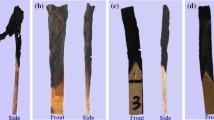Abstract
Flame-retardant polymer composites with specific, finely dispersed fillers were obtained using eco-friendly water-based polyurethane adhesives for coatings on wood panels and were composed of waterborne polyurethane (WPU), aluminum trihydroxide (ATH) and mica. WPU was synthesized from the polycondensation of isophorone diisocyanate (IPDI), polyethylene glycol (PEG), poly(propylene glycol) (PPG), ethylenediamine (EDA), 2,2′-bis(hydroxymethyl)-propionic acid (DMPA) and triethylamine (TEA). These composites were characterized by thermogravimetric analysis (TGA), differential scanning calorimetry (DSC), scanning electron microscopy (SEM), transmission electron microscopy (TEM), flammability testing, environmental testing and impact resistance testing. It was shown that the WPU can serve as an effective dispersant that blends with ATH and mica not only improving the dispensability properties but also enhancing the flame retardant properties. For example, the thermal decomposition temperature for a 5 % weight loss (Td 5%) reached 325 °C when the hybrid flame retardants were comprised of 10 g WPU and 100 g ATH/mica in a 15/85 ratio (10 WPU/15 ATH/85 mica). In comparison, with pure WPU, the thermal decomposition temperature for a 5 % weight loss (Td 5%) was only 255 °C. In addition, the fire retardant grade for flame retardant composites comprised of 10 WPU/15 ATH/85 mica (10/15/85 weight ratio) and wood panel reached level 2 in accordance with CNS 14705 (Chinese National Standard 14705).









Similar content being viewed by others
References
Irvine D, McCluskey J, Robinson I (2000) Polym Degrad Stab 67:383–396
Chuang CS, Tsai KC, Yang TH, Ko CH, Wang MK (2011) Appl Clay Sci 53:709–715
Stevens GC (2000) Countervailing risks and benefits in the use of flame retardants, in flame retardants. Interscience Communications, London
Camino G, Costa L (1988) Polym Degrad Stab 20:271–294
Laoutid F (2009) Mater Sci Eng R 63:100–125
Pearce EM, Khanna YP, Reucher D (eds) (1981) Thermal characterization of polymeric materials. Academic Press, New York
Hilaldo CJ (ed) (1990) Flammability handbook for plastics. Technomic Publishing, Lancaster
Hastie JW (1973) J Res Natl Bur Stand 77a:733–754
Bonsignore PV, Manhart JH (1974) In: Proceedings of the Annual Conference of Reinforced Plastic, Compos. Inst Soc Plast Ind 29:23c–23c
Judeinstein P, Sanchez C (1996) J Mater Chem 6:511–525
Daniel N, Fisher M, Tran L, Matisons JG (2002) J Am Chem Soc 124:13998–13999
Al-Salah H (1988) J Polym Sci Part A: Polym Chem 26:1609–1620
Egboh S (1983) J Macro Sci Chem 19:1041–1048
Liu Y, Huang Y, Liu L (2007) Compos Sci Technol 67:2864–2876
Lefebvre J, Bastin B, Bras ML, Duquesne S, Ritter C, Paleja R, Poutch F (2004) Polym Test 23:281–290
Cross M, Cusack P, Hornsby P (2003) Polym Degrad Stab 79:309–318
Matthieu B, Katharina L (2003) Macro 36:5119–5125
Ho TJ, Moon KJ, Byung KK, Kwang HK (2007) Colloid surf a-physicochem. Eng Asp 302:559–567
Aitziber L, Elise D-C, Elisabetta C, Costantino C, Joseph L, Keddie Jose MA (2011) Langmuir 27:3878–3888
Faure B, Alvarez GS, Ahniyaz A, Villaluenga I, Berriozabal G, Miguel YD, Bergstrom L (2013) Sci Technol Adv Mater 14:02301–02323
Vahabi H, Batistella MA, Otazaghine B, Longuet C, Ferry L, Sonnier R, Lopez-Cuesta JM (2012) Appl Clay Sci 70:58–66
Acknowledgments
The authors gratefully acknowledge the support for this research by the Ministry of Economic Affairs in Taiwan under the grant numbers 103-EC-17-A-08-S1-205 and Ministry of Science and Technology in Taiwan under the grant numbers 104-2221-E-002-159 and NSC 102-2221-E-037-001 -MY3, respectively. This study is also supported partially by Kaohsiung Medical University “Aim for the Top Universities Grant, grant No.: KMU-TP104B03”.
Author information
Authors and Affiliations
Corresponding authors
Rights and permissions
About this article
Cite this article
Chang, WY., Pan, YW., Chuang, CN. et al. Fabrication and characterization of waterborne polyurethane (WPU) with aluminum trihydroxide (ATH) and mica as flame retardants. J Polym Res 22, 243 (2015). https://doi.org/10.1007/s10965-015-0888-y
Received:
Accepted:
Published:
DOI: https://doi.org/10.1007/s10965-015-0888-y




